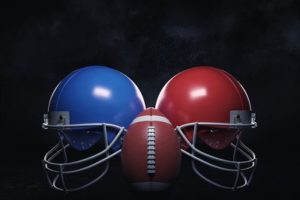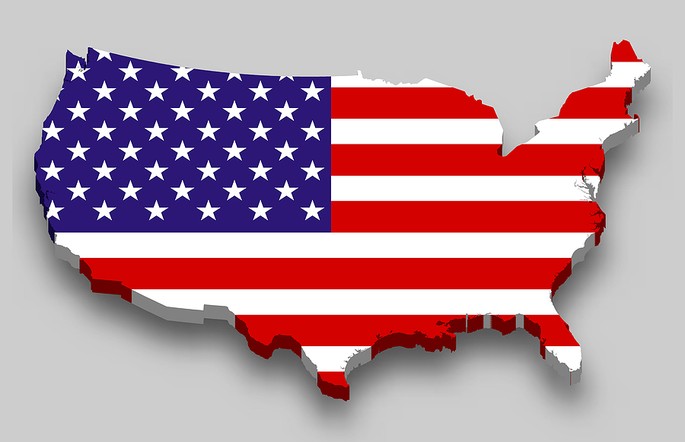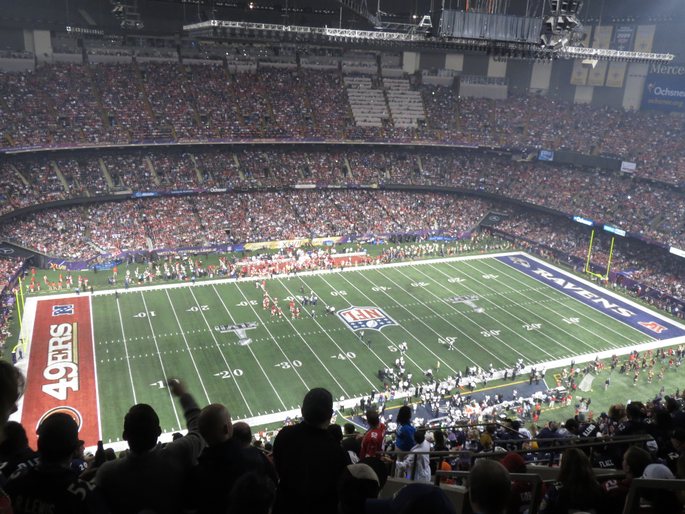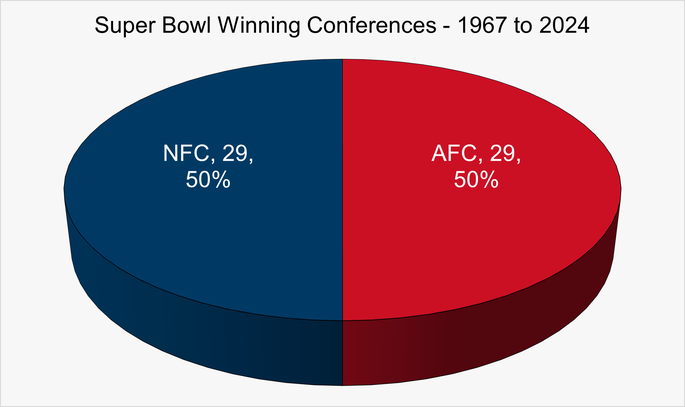 To those outside of the United States of America that don’t know much about American football, the Super Bowl can seem like a strange and impenetrable event. Taking place once a year, it pitches the winners of the National Football Conference against the team that wins the American Football Conference for the right to declare themselves world champions in the sport. It first took place in 1967 after the 1966 regular season and has happened every year since.
To those outside of the United States of America that don’t know much about American football, the Super Bowl can seem like a strange and impenetrable event. Taking place once a year, it pitches the winners of the National Football Conference against the team that wins the American Football Conference for the right to declare themselves world champions in the sport. It first took place in 1967 after the 1966 regular season and has happened every year since.
Teams that win the Super Bowl go down in history, but the biggest battle is arguably between the two different conferences to see which one gets to boast supremacy. At the time of writing, the honours are shared between twenty different teams, with eleven of them coming from the National Conference and nine from the American Conference.
Quick Answer: Which Conference Has Won the Most Super Bowls, the NFC or the AFC?
Between Super Bowl I in 1967 and Super Bowl LVIII in 2024, the NFC/NFL have won 29 times (50%) and the AFC/AFL have won 29 times (50%), an exactly equal split between the two conferences.
Conferences Explained

In the world of American football, the National Football League was the dominant variance after its creation in 1920. Several different rival leagues were formed over the years, but the NFL successfully fended them all off. That is until the American Football League was formed in 1960, quickly vying with the NFL for both fans and players to join its roster and giving it a sense of legitimacy.
In the wake of the AFL’s first season, its commissioner, Joe Foss, sent the NFL an invitation to take part in a ‘World Playoff’, which would involve the champions of the two leagues from the 1961 season. The match never took place, but when merger talks between the two leagues began to take place, the idea of having such a match was quickly put on the agenda.
The AFL had been borne out of a desire to see football played across the country, with the teams turning to the largely ignored predominantly black colleges for its star players. It also introduced rules and policies that were later adopted by the NFL, proving that it was a well-organised and structured league. There were only eight teams in the AFL initially, allowing the NFL to essentially ignore its existence.
The main advantage boasted by the AFL was that its owners were richer than their NFL equivalents, meaning that they could absorb financial losses whilst they waited to be taken seriously. They thrived and grew, signing a broadcast deal with NBC worth $36 million that meant that the NFL had to start considering them as real rivals. Tit-for-tat signings between leagues soon started, leading to the merger.
Who Plays In The Super Bowl

By djanimal, flickr
The merger agreement was announced on the eighth of June 1966, seeing the two leagues combine to create one large league that would feature 24 teams, expanding to 26 by 1969 and 28 by 1970. The two leagues would hold what was referred to as a ‘Common Draft’ of college players, stopping the need for bidding wars. They would still play two separate regular seasons, with one AFL-NFL World Championship Game.
In 1970, the two leagues merged to form one league that had two conferences. The AFL teams had quickly decided that geography would determine which teams would play in which conference, but NFL sides struggled to make a similar decision. In the end, it was essentially decided according to the drawing of lots, with the teams decided upon and the two conferences officially formed.
Though there have been some small changes over the years, it has been general the same since then, with a given number of teams playing in the American Football Conference and others playing in the National Football Conference during the normal season. The winning team from each conference then goes head-to-head in the Super Bowl at the end of the season. For English football fans, it’s as if the winners of the Premier League and the winners of the Bundesliga played a match every summer.
Because of the way the match works, it would be impossible for two teams from the same conference to ever play each other. In other words, two AFC teams couldn’t ever meet in the Super Bowl and neither could two NFC sides. It is specifically a game between the winners of the AFC and the winners of the NFC, designed to figure out which is technically the best team, and therefore the strongest conference, that year.
The Most Successful Conference
Though the Super Bowl’s popularity outside of the United States of America grows year on year, the truth is that it is still only in the US where it is a must-watch. It is second only to the UEFA Champions League in terms of global audience and is the most-watched broadcast in its home country. In American television history, the top five most-watched events are all Super Bowls.
Broadcasters charge more money for adverts during the Super Bowl than any other event in the year, with only Thanksgiving Day beating Super Bowl Day in terms of food consumption. Whichever metric you use, then, it’s fair to say that the Super Bowl is an event that is much-loved by audiences around the world. The one question that not everyone will know the answer to is which conference is the most successful.

As of Super Bowl LVIII in 2024, the NFC and the AFC are level at 29-29, suggesting that there is no one dominant conference in American football’s existence.
Full List of Super Bowl Winners and Their Conference
Here’s a look at the Super Bowls between 1967 and 2024, with information on the team from the AFC that played in it, the team from the NFC that played in it and the winning conference:
Super Bowl Winners – 1967 to 2024
| Year | AFC/AFL Team | Score | NFC/NFL Team | Winning Conference |
|---|---|---|---|---|
| 2024 | Kansas City Chiefs | 25-22 | San Francisco 49ers | American (AFC) |
| 2023 | Kansas City Chiefs | 38-35 | Philadelphia Eagles | American (AFC) |
| 2022 | Cincinnati Bengals | 20-23 | Los Angeles Rams | National (NFC) |
| 2021 | Kansas City Chiefs | 9-31 | Tampa Bay Buccaneers | National (NFC) |
| 2020 | Kansas City Chiefs | 31-20 | San Fransisco 49ers | American (AFC) |
| 2019 | New England Patriots | 13-3 | Los Angeles Rams | American (AFC) |
| 2018 | New England Patriots | 33-41 | Philadelphia Eagles | National (NFC) |
| 2017 | New England Patriots | 34-28 | Atlanta Falcons | American (AFC) |
| 2016 | Denver Broncos | 24-10 | Carolina Panthers | American (AFC) |
| 2015 | New England Patriots | 28-24 | Seattle Seahawks | American (AFC) |
| 2014 | Denver Broncos | 8-43 | Seattle Seahawks | National (NFC) |
| 2013 | Baltimore Ravens | 34-31 | San Fransisco 49ers | American (AFC) |
| 2012 | New England Patriots | 17-21 | New York Giants | National (NFC) |
| 2011 | Pittsburgh Steelers | 25-31 | Green Bay Packers | National (NFC) |
| 2010 | Indianapolis Colts | 17-31 | New Orleans Saints | National (NFC) |
| 2009 | Pittsburgh Steelers | 27-23 | Arizona Cardinals | American (AFC) |
| 2008 | New England Patriots | 14-17 | New York Giants | National (NFC) |
| 2007 | Indianapolis Colts | 29-17 | Chicago Bears | American (AFC) |
| 2006 | Pittsburgh Steelers | 21-10 | Seattle Seahawks | American (AFC) |
| 2005 | New England Patriots | 24-21 | Philadelphia Eagles | American (AFC) |
| 2004 | New England Patriots | 32-29 | Carolina Panthers | American (AFC) |
| 2003 | Oakland Raiders | 21-48 | Tampa Bay Buccaneers | National (NFC) |
| 2002 | New England Patriots | 20-17 | St. Louis Rams | American (AFC) |
| 2001 | Baltimore Ravens | 34-7 | New York Giants | American (AFC) |
| 2000 | Tennessee Titans | 16-23 | St. Louis Rams | National (NFC) |
| 1999 | Denver Broncos | 34-19 | Atlanta Falcons | American (AFC) |
| 1998 | Denver Broncos | 31-24 | Green Bay Packers | American (AFC) |
| 1997 | New England Patriots | 21-35 | Green Bay Packers | National (NFC) |
| 1996 | Pittsburgh Steelers | 17-27 | Dallas Cowboys | National (NFC) |
| 1995 | San Diego Chargers | 26-49 | San Fransisco 49ers | National (NFC) |
| 1994 | Buffalo Bills | 13-30 | Dallas Cowboys | National (NFC) |
| 1993 | Buffalo Bills | 17-52 | Dallas Cowboys | National (NFC) |
| 1992 | Buffalo Bills | 24-37 | Washington Redskins | National (NFC) |
| 1991 | Buffalo Bills | 19-20 | New York Giants | National (NFC) |
| 1990 | Denver Broncos | 10-55 | San Fransisco 49ers | National (NFC) |
| 1989 | Cincinnati Bengals | 16-20 | San Francisco 49ers | National (NFC) |
| 1988 | Denver Broncos | 10-42 | Washington Redskins | National (NFC) |
| 1987 | Denver Broncos | 20-39 | New York Giants | National (NFC) |
| 1986 | New England Patriots | 10-46 | Chicago Bears | National (NFC) |
| 1985 | Miami Dolphins | 16-38 | San Fransisco 49ers | National (NFC) |
| 1984 | Los Angeles Raiders | 38-9 | Washington Redskins | American (AFC) |
| 1983 | Miami Dolphins | 17-27 | Washington Redskins | National (NFC) |
| 1982 | Cincinnati Bengals | 21-26 | San Fransisco 49ers | National (NFC) |
| 1981 | Oakland Raiders | 27-10 | Philadelphia Eagles | American (AFC) |
| 1980 | Pittsburgh Steelers | 31-19 | Los Angeles Rams | American (AFC) |
| 1979 | Pittsburgh Steelers | 35-31 | Dallas Cowboys | American (AFC) |
| 1978 | Denver Broncos | 10-27 | Dallas Cowboys | National (NFC) |
| 1977 | Oakland Raiders | 32-14 | Minnesota Vikings | American (AFC) |
| 1976 | Pittsburgh Steelers | 21-17 | Dallas Cowboys | American (AFC) |
| 1975 | Pittsburgh Steelers | 16-6 | Minnesota Vikings | American (AFC) |
| 1974 | Miami Dolphins | 24-7 | Minnesota Vikings | American (AFC) |
| 1973 | Miami Dolphins | 14-7 | Washington Redskins | American (AFC) |
| 1972 | Miami Dolphins | 3-24 | Dallas Cowboys | National (NFC) |
| 1971 | Baltimore Colts | 16-13 | Dallas Cowboys | American (AFC) |
| 1970 | Kansas City Chiefs | 23-7 | Minnesota Vikings | American (AFL) |
| 1969 | New York Jets | 16-7 | Baltimore Colts | American (AFL) |
| 1968 | Oakland Raiders | 14-33 | Green Bay Packers | National (NFL) |
| 1967 | Kansas City Chiefs | 10-35 | Green Bay Packers | National (NFL) |
You can see, then, that the dominance of the National Football Conference teams in the 1980s and into the 1990s put them in an incredible strong position, with the American Football Conference sides winning regularly since the beginning of the Super Bowl’s existence.
